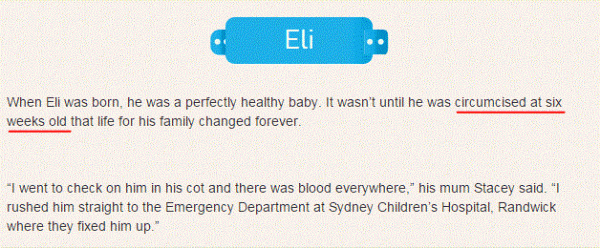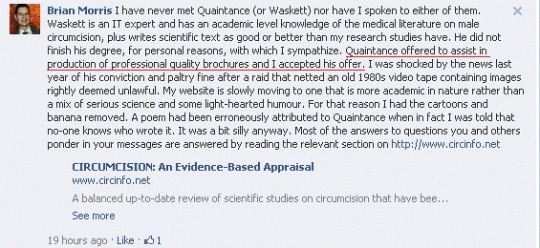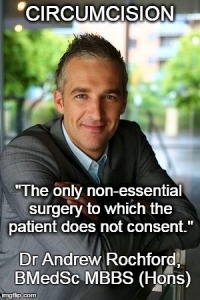As I paced the hallways while waiting for my daughter to recover from her surgery at the Sydney Children’s Hospital in Randwick, Sydney, I read a poster on the wall which outlined the hospital’s policies around its care for its patients.
I was reassured to read a number of points in relation to the quality of care that the hospital promised. In particular, I was pleased to read a point which was highlighting the right of bodily autonomy. While I can’t remember the exact wording, I recall that it was something like this:
“Children’s bodies are their own.”
Infant circumcision for non-medical reasons was banned in NSW public hospitals in 2006, and as the Sydney Children’s Hospital is a public hospital there should be no non-therapeutic circumcisions being performed there. However, the doctors who practise there can easily bypass this ban by operating out of one of the private clinics surrounding the hospital. I wondered how many of these doctors walked past these posters every day, then walked over to a private clinic to perform this life-changing and damaging procedure on a non-consenting infant.
Nonetheless, I was pleased to read that the hospital seemed to understand the concept of bodily autonomy – that children owned their bodies, and that in the absence of a clear and immediate medical need, they should get to determine what happens to them.
So I was surprised to see that for the foundation’s Gold Telethon 2015 they would be promoting a story of a child rushed to the emergency department as a result of a procedure that is an assault on that autonomy – infant circumcision. Here is a screen shot from the foundation’s website on 5 March 2015:

While the exact timing is unclear, sometime before 23 April 2015 (according the the web archive), the foundation updated the page to remove any reference to the circumcision. This is how the page appeared from that date, and still appears at the time this post was published:

Note that the red underlines have been added to both screenshots to highlight the differences.
When approached for an explanation, a spokesperson for the foundation responded with “We updated the original story as we believed the detail to be irrelevant to the focus of our story – Eli and his treatment for Haemophilia”.
It appears to be unlikely that this reason alone is why the story was changed. In my experience, these types of articles are updated to correct important omissions or errors, or to remove details that are distracting to the story – not merely irrelevant.
The two other stories used to promote the 2015 Gold Telethon also contained information that could easily be determined as ‘irrelevant’. Why were those details not also removed?
The real reason for the revision is open to speculation. An obvious response to the unedited story would be to question why (in its own words) a ‘perfectly healthy baby’ was subjected to unnecessary surgery in the first place. I imagine it was easier for the foundation to sweep this distraction under the carpet rather than address the issue.
The other obvious unanswered questions are ‘who?’ and ‘where?’. It would be difficult for the foundation to claim how heroic the doctors at its hospitals were in treating the child if the situation they were treating was caused by an unnecessary surgery performed by one of its own doctors. Through its spokesperson, the foundation confirmed that the procedure was not carried out at either Sydney Children’s Hospital, Randwick or The Children’s Hospital at Westmead, but they did not respond to the question of whether it was performed at a private clinic by one the doctors who also practises at one of its hospitals.
Paul Mason, Chair of the Australasian Institute for Genital Autonomy, said “This report and the hospital’s suppression of a central fact about the case are deplorable. All across the world “adverse events” from unnecessary genital surgery on babies and children are shrouded in mystery. It is simply not possible for anyone to pretend that any “benefits” outweigh the obvious risks of these dangerous practices if the risks remained hidden and unknown. Parents are entitled to know the truth and the whole of the truth.”
I hope that in the lead up to the Gold Telethon 2016, the foundation chooses a better example of how the medical profession is helping, rather than hurting children.
Image courtesy of Goldy at FreeDigitalPhotos.net













